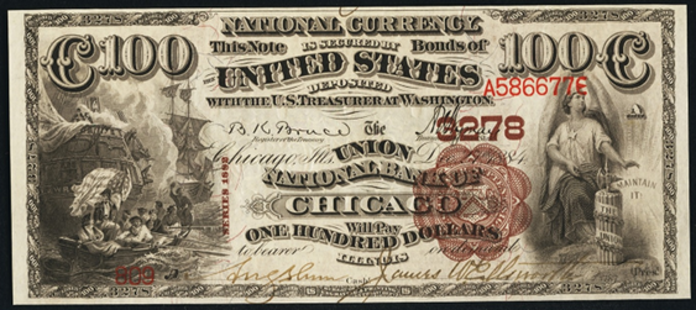One Hundred Dollar Notes › Nationals › 1882 One Hundred Dollar National Bank Notes › Pennsylvania Charters › 1882 $100 Mifflinburg Pennsylvania First National Bank
Get Value Now
| Item | Info |
|---|---|
| Series | 1882 |
| Charter | #174 First National Bank of Mifflinburg, Pennsylvania |
| Year Chartered | 1863, 179 Banks Chartered |
| City Info | Mifflinburg is a borough in Union County, Pennsylvania, United States. The population was 3,594 at the 2000 census. In 1792, S. Lulis and Catharina Jungman and their two children, came from Fort Augusta Pennsylvania to the Buffalo Valley to settle on land given to them by Catharina’s father. They divided the land into 60’ by 120’ plots that were sold to other adventurous settlers, many of them German, and the village of Youngmanstown was formed. A few years later George Rote laid out a village just east of Youngmanstown, known as Greenville or Rotestown, after George’s death. Eventually, the two settlements merged at Third Street. In 1827 the two villages combined and were incorporated. The combined village was named Mifflinburg, in honor of Thomas Mifflin, the first Governor of Pennsylvania after the 1790 Constitution. Source: Wikipedia |
| Similar Cities | City name is unique, no others like it. |
| Seal Varieties | Brown, Blue |
| See Also | If your note doesn't match try: 1. 1882 $100 Gold Certificate 2. 1878 $100 Legal Tender 3. 1880 $100 Legal Tender |
| Other Info | 1. Value depends on notes known for charter, condition and market demand. 2. Rare and highly desirable National Note. |
| Neat Fact | Full and partial sheets of National Bank Notes are known to exists. Families of bank officials, particularly those who signed the notes, kept them as keepsakes. Some sheets are extremely valuable. Others are more common. |
No Obligations Offers and Appraisals
Please submit a good photo or scan. It will be identified and evaluated. Understand there may be subtle differences between the image you see above and your note. Signatures, design, markings and note condition will determine the offer price. Notes in Uncirculated or better condition receive the best offers.
Appraisals can be estimated for wholesale and retail prices. Wholesale is what dealers typically pay. Retail is what a collector might pay. Retail is slightly higher in most cases.
Please visit this page for USA Paper Money Reference. Do not treat this page as a reference guide, it is for appraisal and acquisition purposes only.
